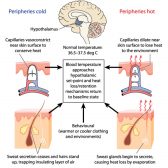Gene Action – Operon Hypothesis

Schematic diagram of bacterial lactose operon
Table of Contents
Reviewed by: Mary Anne Clark, Ph.D.
Some genes are switched on or off depending on environmental conditions. The first genetic regulators were discovered in bacteria.
Operon Hypothesis – Enzyme Induction
In bacteria, genes that code for proteins required for the same metabolic or biosynthetic pathway are often clustered in groups called operons The lac operon in E. coli encodes enzymes required for the metabolism of the disaccharide lactose. The regulation of these genes was first analyzed by Jacob and Monod, whose work was awarded a Nobel Prize in 1965.

The first gene in the operon is for B-galactosidase, which breaks lactose into its two subunits, glucose and galactose. The regulators of the operon ensure that the genes are transcribed only when lactose is present. The following diagrams illustrate the basic features of the model developed by Jacob and Monod. There are three types of genes in the model: structural genes, operator genes, and regulatory genes. Only one of each type is shown in the figure.
- The structural genes are responsible for the production of enzymes used in biochemical pathways
- The regulator gene shown here encodes a repressor protein.
- The operator gene binds the repressor protein, which determines whether the structural gene is switched on or off.
- The repressor protein has binding sites for both lactose (in this instance) and for the operator DNA. In the lac operon, binding to lactose alters the folding of the repressor protein and prevents it from binding to the operator region.
Lactose Absent

When lactose is absent, the repressor molecule attaches itself to the operator gene, effectively switching it off. Transcription of the structural genes requires the enzyme RNA polymerase to bind to a region called the promoter, which in the lac operon is just upstream (left) of the operator site. See the figure at the top of the page. When the repressor protein is bound to the operator, it prevents transcription.
Lactose Present

- When lactose is present, the repressor molecule is unable to attach itself to the operator gene.
- The structural genes are now open to transcription, and the gene for beta-galactosidase, is transcribed and then translated.
- The enzyme protein breaks down the lactose into glucose and galactose.
- In this case, lactose is called the inducer, since its presence activates enzyme induction.
This type of gene regulation is typical for operons that encode enzymes whose job is to break down some substrate molecules. In operons that encode enzymes involved in biosynthetic pathways, the interaction among the various elements of the operon is a little different. For example in the trp operon, whose structural genes encode enzymes required for the synthesis of the amino acid tryptophan, the repressor protein is activated by binding to tryptophan, so that the enzymes are synthesized only when tryptophan is absent.
The next lesson investigates some of the features of gene regulation in eukaryotes.
You will also like...

The Evolutionary Development of Multicellular Organisms
Multicellular organisms evolved. The first ones were likely in the form of sponges. Multicellularity led to the evolutio..

Chemical Composition of the Body
The body is comprised of different elements with hydrogen, oxygen, carbon, and nitrogen as the major four. This tutorial..

Cell Respiration
Cell respiration is the process of creating ATP. It is "respiration" because it utilizes oxygen. Know the different stag..

Temperature Regulation in Animals
This tutorial elucidates body temperature regulation. Know the details here to learn how the body sets the body temperat..

Plant Tissues
Plant organs are comprised of tissues working together for a common function. The different types of plant tissues are m..

Protein Variety
The sequence of amino acids determines the type of protein. Protein is synthesized according to the sequence of nucleoti..
